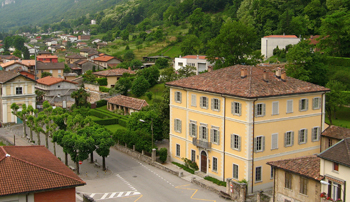|
|
|
|
|
 |
|
|
|
|
|
|
|
|
|
|
|
|
|
|
|
|
Villa Maderni was constructed in the mid-1700s, reportedly for Abbondio Bernasconi, a lawyer who served as leader of the Republic of Riva San Vitale for 25 days before the republic was overthrown. The villa was purchased by the Virginia Tech Foundation in 1991 and was rented by the university to serve as the base of operations for the newly established Center for European Studies and Architecture.
Following its purchase, Villa Maderni was completely renovated, including updates to plumbing and wiring and restoration of its beautiful frescoed ceilings, which are painted so well that they have a dimensional look. Visitors enter the 19,259 square-foot building through double doors that lead into a columned, Lombard-style entry hall.
The grounds, which cover approximately 1.1 acres, include a spacious garden and patio and a gated courtyard bordered on one side by former horse stables. Villa Maderni faces Via Settala, an ancient Roman road.
|
|
|
|
|
|
|
|
|
|
|
|
|
|
|
|
|
|
|
|
|
|
|
 |
|
|
|
|
|
|
|
|
|
|
|
|
|
|
|
 |
|
|
|
|
|
|
|
|
|
|
|
|
|
|
|
 |
|
|
|
|
|
|
|
|
photos by Larry Hincker
|
|
|
|
|
|
|
|
|
In a small, ancient, picturesque Swiss town and the region surrounding it, Virginia Tech students learn how to interact with--and appreciate--cultures quite different from their own.
The late Olivio Ferrari, Alumni Distinguished Professor at Virginia Tech, often talked about the need for students to have "the international dimension." When he and his wife, Lucy, a language and culture instructor, came across an impressive 250-year-old villa in Riva San Vitale, Switzerland, in the late 1980s and helped President Charles Steger, then dean of architecture and urban studies, convince university officials to purchase it, they expanded opportunities for Virginia Tech students to acquire that dimension.
Since opening in 1994, the three-story, pale yellow house, called Villa Maderni, has served as the base for the university’s Center for European Studies and Architecture (CESA). Managed by the Office of International Research, Education, and Development, the center offers university-wide study abroad programs.
CESA programs span a range of topics, from preparing future faculty for global perspectives to courses on biologically inspired materials. Colleges and departments design their own courses and programs, and professors gear their syllabi to the strategically located setting in the Italian-speaking Ticino region of Switzerland. Thus, students spread beyond Riva San Vitale, making educational forays into other parts of Europe.
During the past 15 years, more than 1,000 students have taken advantage of CESA programs. According to Paul Knox, University Distinguished Professor and Senior Fellow for International Advancement, these students "broaden their intellectual and cultural perspective. They gain self-confidence, adaptability, and self-reliance. As a result of their experience, they also become more competitive in the international marketplace."
Knox calls CESA "a crucial hub" for Tech’s activities in Europe. "Academic distinction now operates in global context: Virginia Tech’s programs must have international impact and visibility and must have the flexibility and agility to create innovative partnerships and collaborations with universities here and abroad."
Anne-Lise Velez (architecture '03), who participated in the study abroad program in fall 2001, compares the knowledge gained by traveling through a foreign country with that gleaned from living in another country. "Traveling creates snapshots of the immediate differences in architecture, in food, manner of dress, and acceptable behaviors of a place," she says. "Living in the same place for a season can create an entirely different view of the world. It provides a sense of the rhythms of the day for the people who live there, how the appearance and mood of the place changes as the weather changes, and how formalities change into everyday slang and familiarities as relationships are formed."
Velez and a few fellow students, who shared an apartment that looked out over the Riva San Vitale Town Hall, learned a lot about town life merely by looking through their windows. "Over the period of several weeks," she recalls, "we learned which cars drove by first in the mornings, that warm weather would draw children to the town hall fountain to spray one another, and which dogs would bark upon seeing another dog or motorcycle."
Italian classes are required as part of some CESA programs, and students use what they learn in daily interactions with native speakers--if they want to communicate. Velez says that such interactions lead to friendships between the students and the locals--and sometimes the friendships lead to impromptu evening soccer matches.
During their sojourn in Riva, many students embrace town life. Velez remembers a festival where students "lined up and shuffled past the huge copper polenta pot before finding places scattered among the various long wooden tables that had been placed in the street for the event. It was at this moment that I felt we truly fit in with the town; we were comfortable spreading out to sit down with strangers because we felt that we were part of the town attending the festival rather than attending guests."
Such exposure to other cultures enhances learning, and many students call their experiences life-changing. Certainly, lessons learned can last a lifetime. Says Velez, "It taught us that no matter how unfamiliar and confusing a particular situation may initially seem, there is always some commonality that can be found, especially over food or sports, and with time, the unfamiliar will become familiar and possibly even comforting."
For more information on CESA, go to www.oired.vt.edu/cesa.

